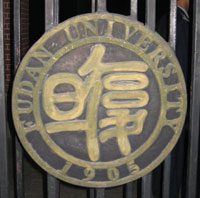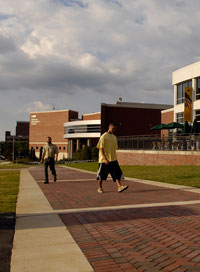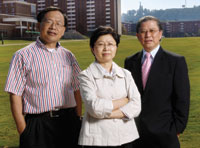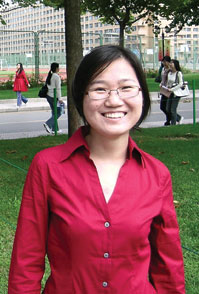Faces of Education in China
By Katherine Walcott
 Photo courtesy of
Photo courtesy of
Katherine Walcott China and the United States—the world’s leading representatives of communism and democracy, of group identity and rugged individualism—are also on opposite sides of the ideological fence when it comes to education. Where American students are encouraged to follow their own interests, Chinese students often have their courses set from above.
Throughout their school years, Chinese students are tested repeatedly. An exam determines what middle school each student will attend. After three years of middle school, a standardized national test determines the student’s path to high school. A good score means a good high school, while a bad score may mean no high school at all—elementary and middle schools are compulsory, but high school is not.
 OPEN AND SHUT While American universities cultivate a sense of connection with the surrounding community, Chinese universities are often walled and gated.
OPEN AND SHUT While American universities cultivate a sense of connection with the surrounding community, Chinese universities are often walled and gated.
Another exam after the first year of high school splits students into two tracks: science or the arts. The arts division includes politics, history, geography, Chinese, and English, so the split essentially divides the hard sciences from everything else. And with China’s continuing drive for modernization, the country’s best and brightest are steered toward math, science, and engineering programs. Opting out of these fields for the arts is strongly discouraged.
After high-school graduation, students sit for a final exam, this one to get into a university. Graduates across the country take the three-day test at the same time, and the pressure is intense. Some thrive, most survive, but many find their path to a promising future suddenly blocked.
What is it like to face such a reckoning as an 18-year-old? What does the future hold when the results don’t go your way? Three UAB researchers and educators—plus one visiting Fulbright scholar—who have felt that pressure offer their views on both the Chinese and American educational systems.
K.C. Pang
International Business/International
Marketing Instructor and Director of China
Initiatives, School of Business
K.C. Pang grew up in Malaysia, where he was educated under the Chinese system—and learned all about the vagaries of higher education. Before Pang took the university admission exam, he was allowed to rank his top choices. Just as in the United States, this is a risky business. If you apply to high-quality schools only but do not pull off a high-quality score, you are out of luck. Most students apply to one good school, one middle-tier school, and one less-competitive school.
In Pang’s case, none of this mattered; he qualified for higher education based on his test score, but strict quotas kept him from being offered a place. So at 25, he elected to go overseas to finish his education. Pang came to Birmingham and UAB, where he could pursue his interest in business and arrange his own course schedule to finish early. After earning his undergraduate degree, he also completed an M.B.A. at UAB.
But Pang has not turned his back on China. Every summer, he spends a month at Anshan Normal University in the city of Anshan, where he holds the title of permanent visiting professor. From this unique vantage point, he can appreciate the strengths of the two systems.
In China, Pang says, “we look at education as a privilege, not an entitlement.” For example, he continues, “if you are assigned to study neurology—even if this is not what you like—you take it as an honor and a privilege. You think, ‘Hey, the government thinks I’m qualified. They assigned me, and I’m going to do it. I don’t want to disgrace my family, and I don’t want to disappoint my government.’”
On the other hand, the rigid hierarchy of the Chinese system can leave students at a disadvantage in a modern business climate that values independent, creative thinking. When Pang first tells his Chinese students to pick their own project topics, for instance, they are lost, because Chinese professors dictate everything in the classroom. But he says the students are quick to learn new methods. “The amazing thing is that after two or three days, the students are transformed,” he says. “It is not that they cannot be independent; it’s just that they are not used to it. Once you give them the choice to be independent, give them guidelines, and hold their hands for a few days, suddenly they can run without you.”
Jian Huang, M.D.
Associate Professor of Medicine,
UAB Cardiac Rhythm Management Lab
 Jian Huang, Xun Ai, and K.C. Pang each see positives in both the American and Chinese educational systems, but they particularly appreciate the American focus on creativity and classroom interaction between teachers and their students.
Jian Huang, Xun Ai, and K.C. Pang each see positives in both the American and Chinese educational systems, but they particularly appreciate the American focus on creativity and classroom interaction between teachers and their students.
Jian Huang was six when the Cultural Revolution began. The brainchild of leader Mao Tse-Tung’s twilight years, the revolution sought nothing less than to reshape an entire culture. In particular it sought to crush China’s ancient intellectual tradition by forcing educated citizens into menial labor in the countryside. After high school, Huang was sent out to a rural area to work as a farmer. Then one day news came that the educational system was being restored. “I was so happy,” Huang recalls. He immediately quit farming and spent three months preparing himself for university entrance exams. At 20, he began a combined undergraduate/medical program.
These days, Huang gets a crosscultural comparison whenever he takes his 19-year-old daughter, Michelle, home to visit family. When they are in China, Michelle’s 21-year-old cousin tells her, “You are so lucky” to live in America.
Huang believes that Chinese children have too many exams and too much homework. His own young niece studies until 10:00 or 11:00 every night as a middle-schooler.
“Generally, education in the United States is more creative,” Huang says. “In school, the children do a lot of things by themselves. In China, the students have to do what the teacher wants and follow the rules.” Class sizes are also smaller in the U.S., Huang notes. “In China, usually you have 40 or 50 children in a big classroom, and for 40 minutes it’s just the teacher standing up in front and talk, talk, talk. The students ask so many questions here. That is a huge difference.”
Xun Ai, M.D.
Assistant Professor of Medicine,
UAB Cardiac Rhythm Management Lab
When your entire academic career rides on one test, what happens if you don’t measure up? After excelling in high school, Xun Ai found out. “I was top in everything in my class,” she says. But years of taking daily tests in each subject bred a cavalier attitude, she recalls, and on the national college entrance exam, “I did sloppy work.” Although math and chemistry were her best subjects, “I didn’t read carefully,” she says. “I misread the questions. And that’s really affected my life. In China, they totally depend on the score.”
Ai ended up at the same medical school in Suzhou as her colleague Jian Huang, M.D., who now works down the hall from her in UAB’s Cardiac Rhythm Management Lab. (Huang has been in Birmingham since the lab was founded 14 years ago, but Ai arrived at the beginning of 2008 from Chicago.)
Ai might not have chosen to attend medical school in Suzhou; with her decent but not stellar test score, however, her options were limited.
Although she has enjoyed her time in the United States, Ai would like to return to China, but she has decided to stay in America until her son Allen’s education is complete. Now a junior in high school, Allen had completed second grade when the family moved to the United States. In China, he never wanted to miss school, even when he was sick, for fear of falling behind in his studies. Now he thinks that someone who can take the day off is lucky, Ai says.
At 11, Allen went back to Shanghai for fifth grade as a sort of trial run to see if the family was ready to return to China. He hated it. “American schools teach problem-solving,” says Ai. “Chinese schools teach by rote. If Allen got the right answer with the wrong method, the answer was wrong.” Both mother and son prefer the American way, but Ai observes that it requires an adjustment. “The other side of freedom is that it requires a lot of maturity.”
Xinxin Ma
Teaching Assistant,
Department of Foreign Languages
In recent years, students in China have been allowed more say in their educations. Xinxin Ma chose to follow her interest in the social sciences, a decision that led to a Fulbright fellowship and a position as teaching assistant to Lily Ong Yang, professor of Chinese language and literature at UAB, for the 2007-2008 academic year.
 Xinxin Ma, who traveled to UAB from Beijing on a Fulbright fellowship, was part of the first class of Chinese students allowed to make their choice of university after taking their entrance exams, rather than before.
Xinxin Ma, who traveled to UAB from Beijing on a Fulbright fellowship, was part of the first class of Chinese students allowed to make their choice of university after taking their entrance exams, rather than before.
In her second year of high school, Ma had to choose between the hard sciences and social sciences. Although she was doing equally well in both subject areas, her teacher suggested that she would get higher scores in social science classes and exams. The second half of her third year of high school was devoted to preparing for the college entrance exam.
Ma’s class was the first group of students allowed to choose their universities after, rather than before, receiving their test scores. She picked the University of International Business and Economics in Beijing, but her course of study was set from above. One of the things she says she admires about UAB is the opportunity students have to experience a range of subjects before they decide on an educational track. Majors in China are hard to switch; switching schools is all but impossible.
The fluidity of the American system is reflected in its architecture, Ma observes. Universities in the United States are not surrounded by walls and gates, whereas “at Chinese universities, there are always bars and three or four doors,” she says. “In America, I haven’t seen any university with closed doors. They are always open, and there’s not a distinction between the university and other parts of the city.”